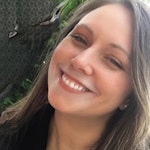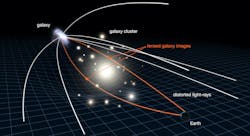Gravitational lens discovery offers broader view of the Universe
We’re getting closer views of stars, planets, and distant galaxies than ever before, thanks to NASA’s Hubble Space Telescope and now the Webb Space Telescope.
An international team, led by ASTRO 3D (All Sky Astrophysics in 3 Dimensions) and the University of New South Wales (UNSW) in Australia, has identified around 100 strong, genuine gravitational lenses via the Keck Observatory in Hawaii and the Very Large Telescope in Chile. This could allow astronomers to see details of objects billions of light years away at unprecedented imaging resolution, and to also better study the evolution of galaxies as far back in time as the Big Bang (see video).
“A gravitational lens, which is a fundamental prediction from Einstein's theory of general relativity, is exactly what you're thinking of in terms of a lens,” says astrophysicist Kim-Vy Tran, a professor at UNSW and a member of the Executive Management Committee for ASTRO 3D. She notes that gravitational lenses are massive objects such as galaxy clusters that create a gravitational pull that distorts and magnifies the light emitted from distant galaxies. This causes it to act as a lens for things that are behind it. “The mass itself is actually bending just like a magnifying glass.”
The researchers didn't expect to find such a high purity rate with the lenses—it’s around 88%. Almost nine out of 10 objects they’re seeing are real gravitational lenses, Tran says, adding that this success rate is particularly exciting because this was only the first survey and analysis the team has done so far.
Most of the Universe’s mass is made of dark matter. Gravitational lenses trace that mass, and with spectroscopy the researchers can detect how it bends light from objects behind it.
Using spectroscopy, enables researchers to map a 3D picture of those lenses at various distances and at much higher resolutions to get a clearer, more complete picture of the Universe and how galaxies have formed throughout history. As the work continues—part of ASTRO 3D’s Galaxy Evolution with Lenses (AGEL) survey—Tran says they could potentially discover a massive number of gravitational lenses.
“This work opens up a whole new discovery space for us,” she says. “Now, instead of just basing things on a few tens of objects, we're going to move into hundreds, maybe thousands, of these. Then we can build up statistical samples and find things that are really unusual at all ranges of cosmic distances.”
Gravitational lenses have been used by astronomers for decades to observe far away galaxies. But historically, it’s been tough to find more than a couple of handfuls of them because existing technologies can’t obtain clear enough images; the resolution is too low to see such small lenses clearly.
“Most of this is usually quite hard to find from the ground because of the atmosphere, which blurs the images,” Tran says. She cites the Dark Energy Survey—a collaboration between numerous organizations worldwide, including the U.S. National Science Foundation, to map hundreds of millions of galaxies to better understand the nature of dark energy. In this project, the collaborative group surveyed the sky using ground-based telescopes in several optical filters. The resolution they achieved is much higher than has been reached in the past, and Tran’s team is now taking such work further.
Her team is sifting through millions of massive objects they’ve imaged and surveyed across a very large area of the sky. “Now, we have the resolution needed to start to identify very distinctive visual signatures,” Tran says. “There's just a whole range of science that this enables for us.”

Justine Murphy | Multimedia Director, Digital Infrastructure
Justine Murphy is the multimedia director for Endeavor Business Media's Digital Infrastructure Group. She is a multiple award-winning writer and editor with more 20 years of experience in newspaper publishing as well as public relations, marketing, and communications. For nearly 10 years, she has covered all facets of the optics and photonics industry as an editor, writer, web news anchor, and podcast host for an internationally reaching magazine publishing company. Her work has earned accolades from the New England Press Association as well as the SIIA/Jesse H. Neal Awards. She received a B.A. from the Massachusetts College of Liberal Arts.


